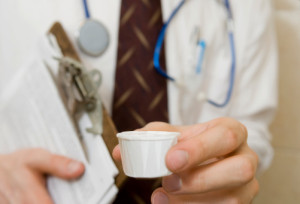Use of the clinical opiate withdrawal scale (COWS) is a common method of assessing opiate withdrawal levels in patients who are in a residential treatment setting as well as in those who are being monitored for medication assisted opiate addiction treatment. The clinical opiate withdrawal scale is a pen and paper method of recording scores for various symptoms of opiate withdrawal on a scale that ranges between 0 and 5. The sum of the numbers determines the level of opiate withdrawal and in a healthcare setting would also determine the next course of action for treatment.
The symptoms of opiate withdrawal that are measured using the clinical opiate withdrawal scale must be solely related to the withdrawal itself and not to some other event or condition. For instance, the first step of measurement is the resting pulse rate. When this is measured, the pulse must be in a resting state which means that the patient must be relaxed and resting, not up moving around or performing any rigorous activity.
Eleven items are measured or assessed using the COWS method. This is a clinician-administered assessment that is not recommended to be performed by anyone who is not educated on the use of this particular method of assessment. Patients who are addicted to opiates are often assessed using the clinical opiate withdrawal scale but this assessment is also used in the healthcare setting when a patient has received opiates for the treatment of pain and is showing adverse signs of opiate withdrawal as a subsequent result.
11 Assessments in the Clinical Opiate Withdrawal Scale
The COWS test measures 11 opiate withdrawal symptoms and rates each based on various criteria as follows:
1. Resting Pulse Rate
The resting pulse rate is recorded by number of beats per minute while the patient is in a relaxed or resting state. The patient must have been in a sitting or lying down position for at least one minute prior to the pulse being measured and there should have been no recent rigorous activity.
If the pulse is 80 or lower, the score for this part of the clinical opiate withdrawal scale assessment is a 0. The score goes up when the heart rate goes up, so for a heart rate of 81-100 the score for assessment purposes is a 1. These rates go up to 4 when the resting pulse rate is greater than 120.
2. Sweating
 The clinical opiate withdrawal scale also assesses the level of a patient’s level of chills or sweating. The score or assessment is determined by the level of sweat over the past 30 minutes. Sweating should be assessed when a patient is in a comfortable temperature and has not recently performed rigorous activity that is conducive to perspiration.
The clinical opiate withdrawal scale also assesses the level of a patient’s level of chills or sweating. The score or assessment is determined by the level of sweat over the past 30 minutes. Sweating should be assessed when a patient is in a comfortable temperature and has not recently performed rigorous activity that is conducive to perspiration.
No report of chills or flushing would accumulate a score of 0 on the COWS test while sweat streaming off of the patient’s face accounts for a score of 4. There are varied scores in between that account for minor chills, minor perspiration and small beads of sweat accumulating on the face.
3. Restlessness
While the healthcare provider is assessing the patient using the clinical opiate withdrawal scale, he or she will determine a level of restlessness in the patient. A score of 0 is given if the patient is able to sit still and stay calm while a score of 5 is given for patients who are unable to sit still for more than a couple of seconds.
4. Pupil Size
The pupils size is assessed in ambient lighting in which a normal pupil size would be pinned. If the patients pupils seem normal, a score of 0 is given but if the pupils are very bold, dilated and leaving only a very slight portion of the iris visible then a score of 5 is given in this area of the COWS assessment.
5. GI Upset
The gastrointestinal tract is often upset very severely in cases of opiate withdrawal which is why part of the clinical opiate withdrawal scale assessment focuses on GI upset. If the patient has had no symptoms of GI upset in the past 30 minutes the score is a 0. If there have been multiple episodes of diarrhea or vomiting in the past 30 minutes a score of 5 is assessed for this portion of the test.
6. Bone or Joint Aches
For the purpose of the COWS assessment, any aches that patient had prior to taking the opiates are not considered as part of the assessment; only the pain associated to opiate withdrawal is to be assessed. Bone or joint aches that are not present are scored as a 0 on the assessment while extreme discomfort brings a score of a 4 for this portion of the clinical opiate withdrawal scale.
7. Runny Nose & Tearing
Cold or allergy symptoms should not be assessed as part of the COWS test but runny nose that is attributed to opiate withdrawal should be considered for this portion of the clinical assessment. A lack of runny nose scores 0 while a persistent runny nose or tears that stream down the face will score a 4. There are other levels in between to account for watery eyes or a mild runny nose.
8. Tremor
The patient is asked to stretch his or her hands out and the healthcare provider will assess the presence of tremors. If there is no indication of shakiness or tremor then a score of 0 is given but if the arms twitching or showing major signs of tremor a score of 4 is given on the clinical opiate withdrawal scale.
9. Anxiety or Irritability
Patients who show no signs of anxiety or irritability are scored a 0 on the COWS assessment for this particular part of the opiate withdrawal test. Patients who show extreme anxiety, seem very anxious or are very irritable are given a score of 4 is given. Scores in between can be given for mild to moderate irritability or anxiousness.
10. Goosebumps
The clinical opiate withdrawal scale provides scores of 0, 3 and 5 for varied levels of gooseflesh on the skin. A score of 0 is given for patients who have smooth skin during assessment. A score of 3 is given when the patient feels hairs standing up on their arms or legs. A 5 is given in the COWS assessment when the gooseflesh is prominent on the arms, legs or other areas of the body.
11. Yawning
The final area of assessment in the clinical opiate withdrawal scale is observed by the healthcare provider while he or she performs other areas of the COWS assessment. The presence of yawning that takes place several times per minute will score a4 while a lack of yawning scores a 0.
All of these scores are totaled to determine the severity of opiate withdrawal and the next plan of action for treatment. A score of 5-12 is considered a mild opiate withdrawal case while a score of 36 or more is considered severe. Patients are treated in various ways based on the outcome of the clinical opiate withdrawal scale assessment and their own individual circumstances.
Resources









